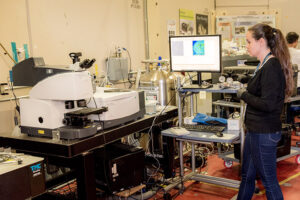 Lawrence Berkeley National Laboratory’s MirroRx is a biomarker technology that accurately predicts disease status. The disease phenotype is analyzed by measuring how the patient’s endogenous molecules vibrate upon exposure to infrared light. The difference between the vibrational profiles of disease and control samples is so visible that the spectral process is like “cellular fingerprinting.” Aggressive cancers such as ovarian and gliomas have low survival rates, but the disease cells have little to distinguish them from non-disease cells. Neither the presence of disease nor its prognosis is predictable. New biomarkers are needed if we are to improve the outcome of clinical trials or to develop more effective therapies. Towards that goal, early results with MirroRx on a handful of samples from presymptomatic patients – who later developed Alzheimer’s – indicate that the technology can spot Alzheimer’s before symptoms develop. If this holds true in future validation trials, spectral phenotyping by MirroRx may, at long last, provide a window of time for patients to try experimental medicines that could delay or even stop disease progression.
Lawrence Berkeley National Laboratory’s MirroRx is a biomarker technology that accurately predicts disease status. The disease phenotype is analyzed by measuring how the patient’s endogenous molecules vibrate upon exposure to infrared light. The difference between the vibrational profiles of disease and control samples is so visible that the spectral process is like “cellular fingerprinting.” Aggressive cancers such as ovarian and gliomas have low survival rates, but the disease cells have little to distinguish them from non-disease cells. Neither the presence of disease nor its prognosis is predictable. New biomarkers are needed if we are to improve the outcome of clinical trials or to develop more effective therapies. Towards that goal, early results with MirroRx on a handful of samples from presymptomatic patients – who later developed Alzheimer’s – indicate that the technology can spot Alzheimer’s before symptoms develop. If this holds true in future validation trials, spectral phenotyping by MirroRx may, at long last, provide a window of time for patients to try experimental medicines that could delay or even stop disease progression.





Tell Us What You Think!